
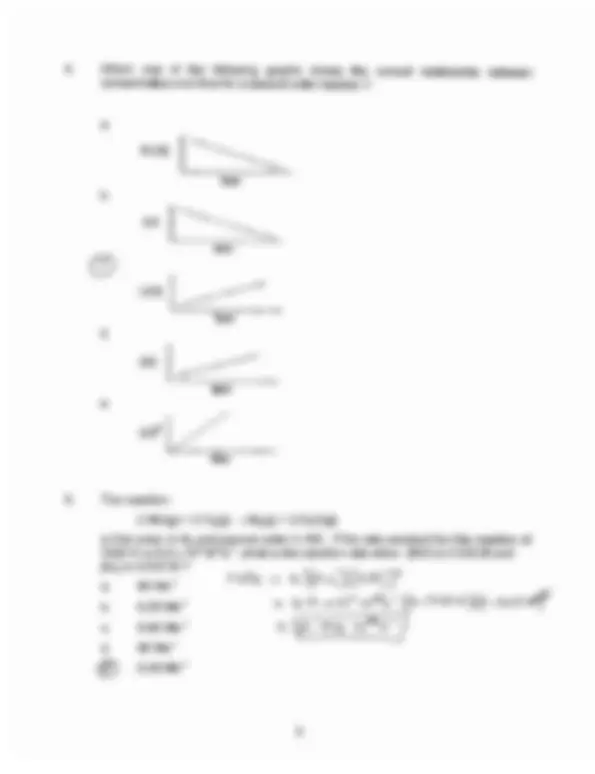
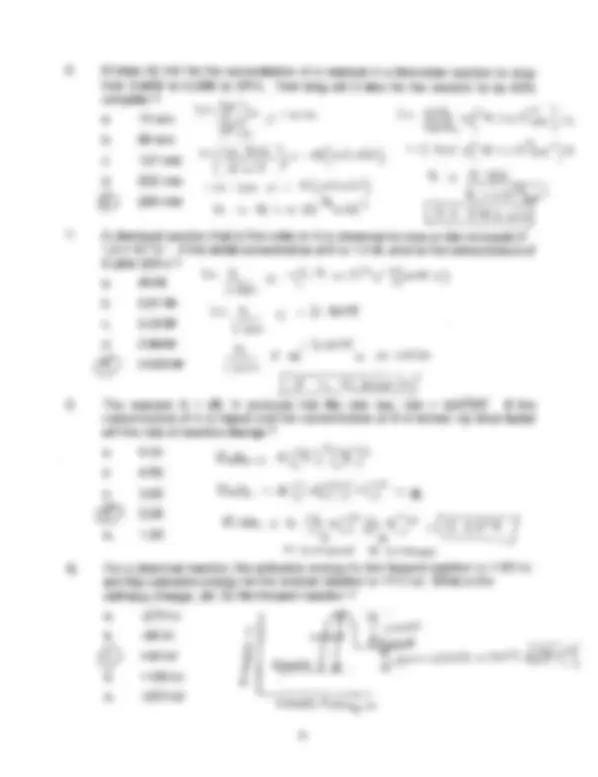
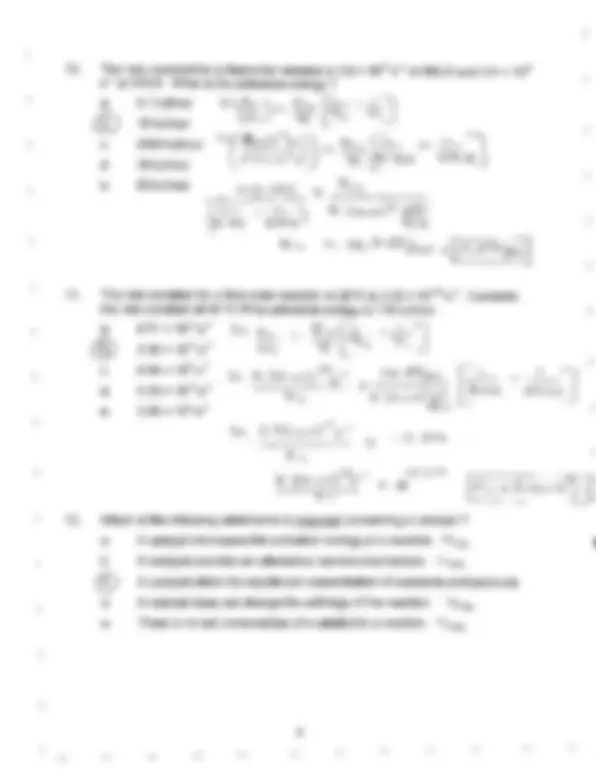
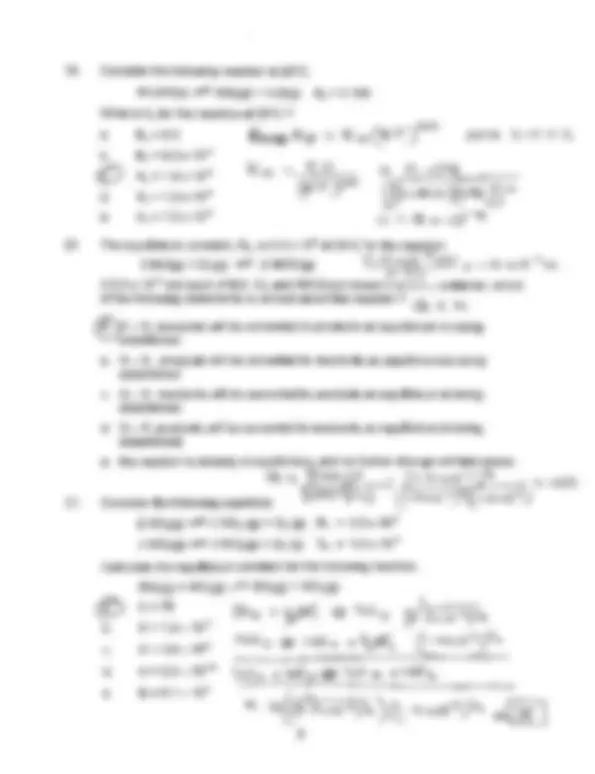

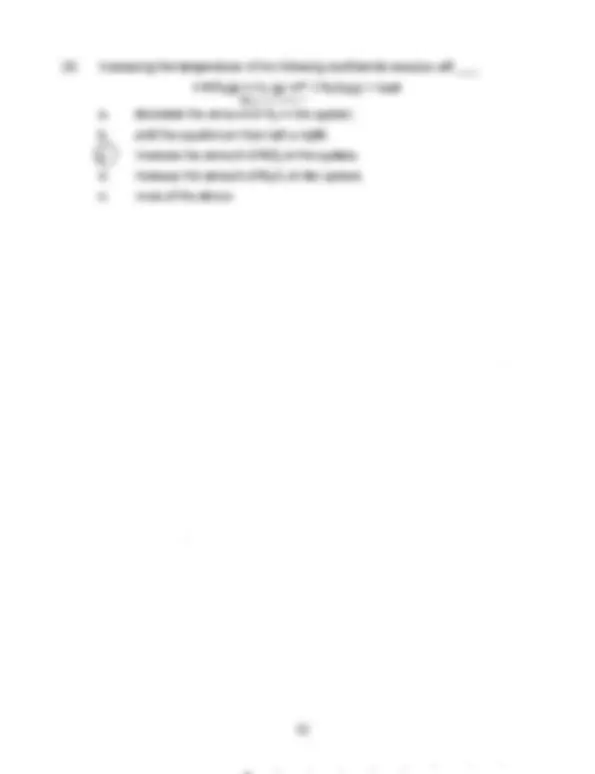


Study with the several resources on Docsity

Earn points by helping other students or get them with a premium plan


Prepare for your exams
Study with the several resources on Docsity

Earn points to download
Earn points by helping other students or get them with a premium plan
Community
Ask the community for help and clear up your study doubts
Discover the best universities in your country according to Docsity users
Free resources
Download our free guides on studying techniques, anxiety management strategies, and thesis advice from Docsity tutors
Material Type: Exam; Professor: Patell; Class: Chemistry 2; Subject: Chemistry; University: Kansas State University; Term: Fall 2011;
Typology: Exams
1 / 10

This page cannot be seen from the preview
Don't miss anything!







I VERSION 1 I
In [A]t =-kt 0.693^1 1 1 k = Ae-Ea/RT
In~= Ea[_1 _~] (^) R =8.314 J mor^1 K-^1 =0.0821 L-atm K-^1 mor^1
lA (^) 8A roo- 1 ~ H 2A 3A 4A 5A 6A 7A He 1.008 (^) 4. 3 4 5 6 7 8 9 10 Li Be (^) B C N 0 F Ne 6.942 9.012 10.81 12.01 14.01 16.00 (^) 19.00 20. (^11 12 13 14 15 16 17 ) Na Mg 3B 4B 5B 6B 7B 8B 8B 8B IB 2B Al (^) Si P S CI Ar 22.99 24.30 26.98 28.09 30.97 32.06 35.45 (^) 39. (^19 20 21 22 23 24 25 26 27 28 29 30 31 32 33 34 35 ) K Ca Sc Ti (^) V Cr Mn Fe Co Ni Cu (^) Zn Ga Ge As Se Br Kr 39.10 40.08 44.96 47.90 50.94 52.00 54.38 55.85 58.93 58.70 63.55 65.39 69.72 (^) 72.59 74.92 78.96 79.90 83. 37 38 39 40 41 42 43 44 45 46 47 48 49 50 51 52 53 54 Rb Sr y^ Zr Nb^ Mo^ Tc^ Ru^ Rh^ Pd^ Ag^ Cd^ In Sn^ Sb^ Te I Xe 85.47 87.62 88.91 91.22 92.91 95.94 98 101.1 102.9 106.4 107.9 112.4 114.8 118.7 121.8 127.6 127.9 131. 55 56 57 72 73 74 75 76 77 78 79 80 81 82 83 84 85 86 Cs Ba La Hf Ta W Re Os Ir Pt Au Hg TI (^) Pb Bi Po (^) At Rn 132.9 137.3 138.9 178.5 181.0 183.8 186.2 190.2 192.2 195.1 197.0 200.6 204.4 207.2 (^) 209.0 209 210 222 87 88 89 104 105 106 107 108 109 110 111 112 114 116 Fr Ra Ac Rf Db Sg Bh Hs Mt Ds Duu^ Dub^ Uuq^ Duh (223) (226) (227) (261) (262)^ (266)^ (264)^ (277)^ (268)^ (281)^ (272)^ (285)^ ~ ~ 58 59 60 61 62 63 64 65 66 67 68 69 70 71 Ce Pr Nd Pm Sm Eu Gd Tb Dy Ho Er Tm Yb Lu 140.1 140.9 144.2 145 150.4 152.0 157.3^ 158.9 162.5 164.9 167.3 168.9 173.0 175. 90 91 92 93 94 95 96 97 98 99 100 101 102 103 Th Pa U Np Pu Am em Bk Cf Es Fm Md No Lr 232.0 231.0 238.0 237.0 244 243 247 247 251 252 257 258 259 260
f1t f1t f1t f1t
b. rate = ~[C3H8] = ~[02] = _~[C02] = _~[H20] f1t f1t f1t f1t
~rate =_~[C3H8] = _1- ~[02] = 1 ~[C02] = 1 ~[H20] ~ f1t 5 f1t 3 f1t 4 f1t
d. rate = ~[C3H8] = 5 ~[02] = _ 3 ~[C02] = _ 4 ~[H20] f1t f1t f1t f1t
e. rate =~[C3H8] = 5 ~[02] = 3 ~[C02] = 4 ~[H20] f1t f1t f1t f1t
a. (^) 5.~x 10-^3 MIs ~ =- - ~ ~L:r:-~ ="~ ~-::t:: 2.J
b. 8.1 x 10-^3 MIs G 6t 6t ~ 1.6 x 10-^3 MIs 6 -:J:::-z.--:J. = - ~ ~-=.J
d. 4.5 x 10-^3 MIs r ~t e. 6.2 x 10-^3 MIs ~. - ~ C"2.>1->£ lO~ t--/S) -:::... t'· b x,D'!> -@
~
c. rate^ =k[NO][CI2l^ ?-~^ '=^ It^ 'f'<..^ ::::-^ 2..^ J
® rate =k[NO]2[CI2] To ~~ ~ '. ~s.e ~=> '2--+ S
e. rate =k[NO]2[CI2]2 '2 '"' = '2-. ~ f"' ~ \ \
from O.45M to 0.32M at 25°C. How long will it take for the reaction to be 90% complete? '. U ']
r!T]o (000)0 l "') b. 86 min
c. 137 min^ \0.^ (^ 0·""3:-^ .^ -=-^ -^ ~q--z.^ M~f)^ ')^ -^ 2 ·~o^ :=t^ "6^ ·^ x^10 ~Miirl-)^ t l O-UcS )
ev
d. 222 min ~o.~Lt =- _ \C...C~2M~{') t = '2..'3,0 3 <tS ~ \ X\O MlA-' e. 284 min -~ '- -\ [ hi K =- '15. \ x. \0 fV\ \f) _ t.::: 2.~ It- M~~
X after 205 s? .. (~ ,- \ ~ ~ =- . q x \ D -:;-\ X2-^0 S s ) a. 49 M '.OM' b. 0.61 M
c. 0.20 M
d. 0.98 M
<9 O.020M
\ X=-o ,0"2.0 8
concentration of A is tripled and the concentration of B is halved, by what factor will the rate of reaction change?
a. 9.
b. 4.
c. 3.50 ~^ =0..^ ~^ LJ-O.:J.2-IT-OJL^ =-^ ~
Rd!e.::: K-. @~o-:J-z.l9~sJ2. :=t2-2~ e. 1. A- (-5 tr.~-ed 13 lS t'c:U.~
+38 kJ
+155 kJ +272 kJ
a. -272 kJ
b. -38 kJ
e.
@ d.
a. 8.1 kJ/mol \f".{£' ) ~E~ ~~ - ~:J ® 19 kJ/mol \¥-"2- \C... [ -J
:~ ::Ok~/~:~OI \l~'~~~;~:~) ~ E~ ~~b~- 6~DJ
e. 80 kJ/mol .... 0. bet s t:~ ~------
(~~ - b~CK)
a. 8.71 x 10-^5 S-1 e'"' \C.- \ .:::.t:.o-....\ ~ lJ-'. ® 3.12x10-^9 S-^1 --y:; \2.- L"2- T\
--\0 ,
'v:-.. -z.
cD A catalyst alters the equilibrium concentration of reactants and products.
c.
d. 1.5 x 10^9
e. 3.0x10^9
2 NOCI(g) -~ 2 NO(g) + CI2(g)
is Kc =1.6 x 10-^5. An equilibrium mixture was found to have the following
Calculate the concentration of NO(g) at equilibrium.
a. 1.0 x 10-^4 M ~^ =^ EJ^0 ~J~-^ @.-^ -z.-)
c. 2.8^ x^ 10-^1 M^ /}JO:J'2.. =. K ft.l0Q.J 7... ":::: Q, 6:X.O-S-)C?-.%,x,o-~) '
d. 2.4^ x^ 10-^2 M^ ts-'l.-3 .. l' r '2-x.lO '2.)
e. 1.6^ x^ 10-^3 M^ l}JoJl...=-. . OL.tS x.O"" {}-jO) =: . 0 x. '-0-2. t-\
What is the equilibrium constant for the reaction below at the same temperature? NO(g) ~- 1/2 N2(g) + 1/2 02(g)
® b.
'"\ha- ~~of'\ ~ ~ ~~ ~
What is the partial pressure of N0 2 at equilibrium if the partial pressure of N204 is 0.0549 atm? Kr =
a. 0.0158atm
b.
0.0791 atm
0.0209 atm
0.0889 atm
0.0377 atm
D ~
?N~0c.r
K~ ~N1--0tr
Y~
~ ~ • \ 4--'-r )~ ,os-lt-'\ ~
=0. OO~1.
1>NO-z :=: ro ~ CJOT-C' ~
~'f~c~~S
Consider the following reaction at 25°C.
What is Kc for the reaction at 25°C?
a. Kc =9.3 ~ K:? =- Kc:. (\2--,)~f'\
b. Kc =9.3 X 10-^3
<C) K Kc..^ ~^ K-t>
4
The equilibrium constant, Kc, is 6.5 x 10^4 at 35°C for the reaction:
2-~C L-
of the following statements is correct about this reaction? a <. K
tf\Q < K, reactants will be converted to products as equilibrium is being Vestablished.
established.
c. Q > K, reactants will be converted to products as equilibrium is being established.
established ..
e. the reaction is already at equilibrium, and no further change will take place. Q '=. ~oc-D'2.. ....... l\ ~ 0 X.()-2..) ~ ..' =- \ 00
Consider the following equilibria: ~oJ 'L~~ (\ rO~o-~'"l-C!'O'ILL~~
Calculate the equilibrium constant for the following reaction:
@) K^ =78^ ~~~~^ 1- _~. ~^ .~ ~(:)3l"2.~3x.\O\ -:r)~z.
c. K^ =1.6^ x^ 10-^4 N()^3 *^ N07-^ ..;:-^ ~A^ Q...-)(()-~)?-L
K =((2-~3X()4-)I" ') ~ 4-XlO~Y2.. .=.ljg J
a. decrease the amount of O 2 in the system.
b. shift the equilibrium from left to right.
© increase the amount of N02 in the system.
d. increase the amount of N 2 0 Sin the system.
e. none of the above.